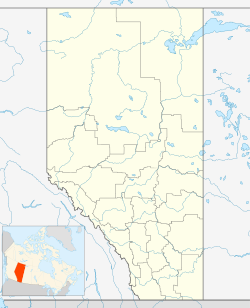Athabasca, Alberta
|
Athabasca Athabasca Landing (1877–1912) |
|
|---|---|
| Town | |
| Town of Athabasca | |
 |
|
| Motto: Gateway to the Great New North | |
| Location of Athabasca in Alberta | |
| Coordinates: 54°43′11″N 113°17′08″W / 54.71972°N 113.28556°WCoordinates: 54°43′11″N 113°17′08″W / 54.71972°N 113.28556°W | |
| Country | Canada |
| Province | Alberta |
| Region | Northern Alberta |
| Census division | 13 |
| Municipal district | Athabasca County |
| Founded | 1877 |
| Incorporated | |
| • Village | May 18, 1905 (as Athabasca Landing) |
| • Town | September 19, 1911 |
| • Name change | August 4, 1913 |
| Government | |
| • Mayor | Roger Morrill |
| • Governing body | Athabasca Town Council |
| • CAO | Doug Topinka (interim) |
| • MP | Shannon Stubbs (Conservative - Lakeland) |
| • MLA | Colin Piquette (NDP - Athabasca-Sturgeon-Redwater) |
| Area (2016) | |
| • Land | 17.65 km2 (6.81 sq mi) |
| Elevation | 533 m (1,750 ft) |
| Population (2016) | |
| • Total | 2,965 |
| • Density | 168/km2 (440/sq mi) |
| Time zone | MST (UTC-7) |
| Postal code span | T9S |
| Area code(s) | +1-780 |
| Website | Official website |
Athabasca /ˌæθəˈbæskə/ (2011 population 2,990), originally named Athabasca Landing, is a town in northern Alberta, Canada. It is located 145 km (90 mi) north of Edmonton at the intersection of Highway 2 and Highway 55, on the banks of the Athabasca River. It is the centre of Athabasca County. It was known as Athabasca Landing prior to August 4, 1913.
Unlike many other towns in Alberta, Athabasca predates the railway. It was the terminus of the Edmonton to Athabasca Landing trail. Athabasca lies on a southern protrusion of the Athabasca River. During the fur trade era, when rivers were the principal means of transportation, the Athabasca–Edmonton trail connected two different drainage basins. The Athabasca River flows north and is part of the Mackenzie River watershed, which leads to the Arctic Ocean. Edmonton lies across a height-of-land on the North Saskatchewan River in the Nelson River drainage basin, which empties into Hudson Bay. Edmonton was in Rupert's Land but not Athabasca. The trail allowed goods to be portaged back and forth between river systems. Once agricultural settlement occurred, the trail served a similar purpose. Eventually, road and rail links would trace the same path.
The Athabasca Heritage Society put up signs through the downtown as well as along the riverfront that explain and depict the history. It has also published a historical walking tour that is available from the town office, library and visitor information centre.
...
Wikipedia

